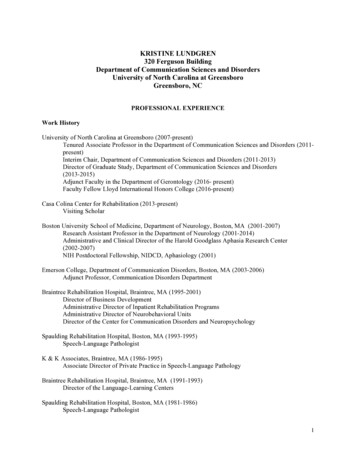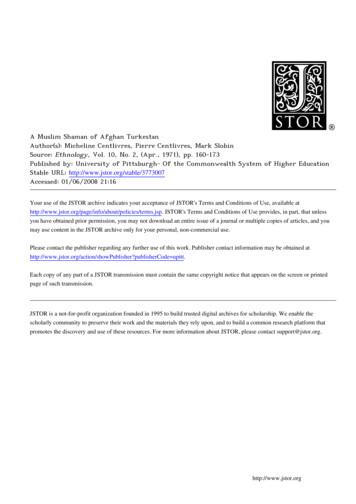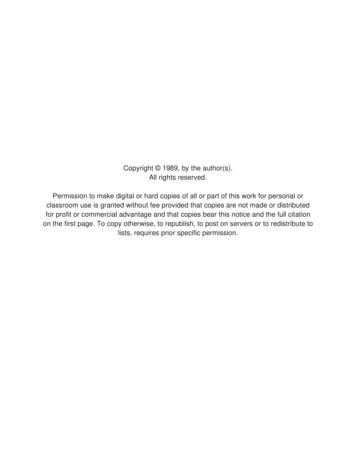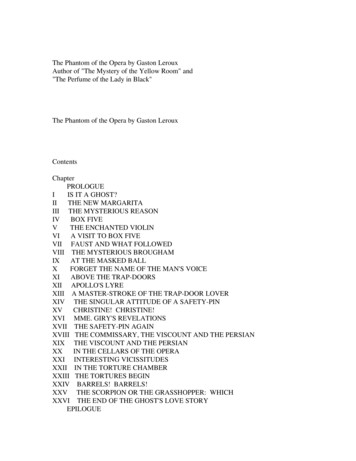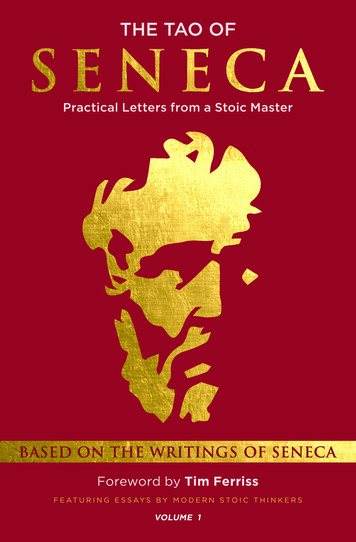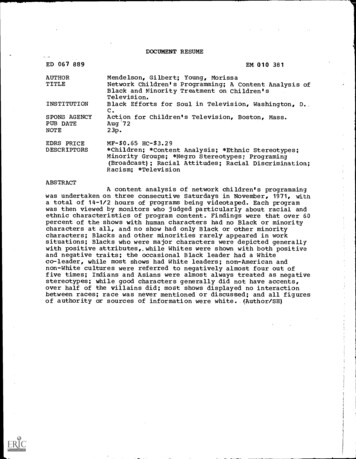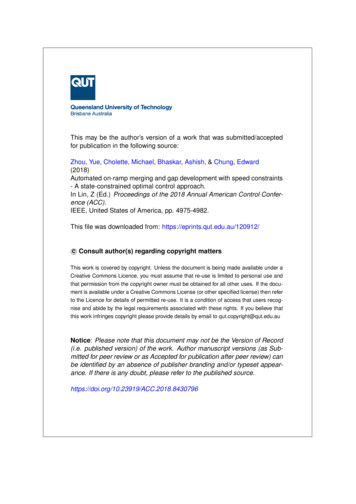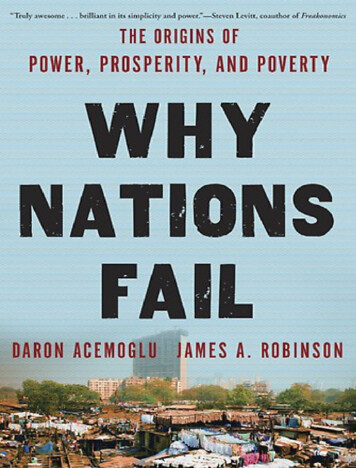
Transcription
PRAISE FOR Why Nations Fail“Acemoglu and Robinson have made an importantcontribution to the debate as to why similar-looking nationsdiffer so greatly in their economic and politicaldevelopment. Through a broad multiplicity of historicalexamples, they show how institutional developments,sometimes based on very accidental circumstances, havehad enormous consequences. The openness of a society,its willingness to permit creative destruction, and the rule oflaw appear to be decisive for economic development.”—Kenneth J. Arrow, Nobel laureate in economics,1972“The authors convincingly show that countries escapepoverty only when they have appropriate economicinstitutions, especially private property and competition.More originally, they argue countries are more likely todevelop the right institutions when they have an openpluralistic political system with competition for politicaloffice, a widespread electorate, and openness to newpolitical leaders. This intimate connection between politicaland economic institutions is the heart of their majorcontribution, and has resulted in a study of great vitality onone of the crucial questions in economics and politicaleconomy.”—Gary S. Becker, Nobel laureate in economics,1992“This important and insightful book, packed with historicalexamples, makes the case that inclusive politicalinstitutions in support of inclusive economic institutions iskey to sustained prosperity. The book reviews how somegood regimes got launched and then had a virtuous spiral,while bad regimes remain in a vicious spiral. This isimportant analysis not to be missed.”—Peter Diamond, Nobel laureate in economics,2010
“For those who think that a nation’s economic fate isdetermined by geography or culture, Daron Acemoglu andJim Robinson have bad news. It’s manmade institutions,not the lay of the land or the faith of our forefathers, thatdetermine whether a country is rich or poor. Synthesizingbrilliantly the work of theorists from Adam Smith toDouglass North with more recent empirical research byeconomic historians, Acemoglu and Robinson haveproduced a compelling and highly readable book.”—Niall Ferguson, author of The Ascent of Money“Acemoglu and Robinson—two of the world’s leadingexperts on development—reveal why it is not geography,disease, or culture that explain why some nations are richand some poor, but rather a matter of institutions andpolitics. This highly accessible book provides welcomeinsight to specialists and general readers alike.”—Francis Fukuyama, author of The End ofHistory and the Last Man and The Origins ofPolitical Order“A brilliant and uplifting book—yet also a deeply disturbingwake-up call. Acemoglu and Robinson lay out a convincingtheory of almost everything to do with economicdevelopment. Countries rise when they put in place the rightpro-growth political institutions and they fail—oftenspectacularly—when those institutions ossify or fail toadapt. Powerful people always and everywhere seek tograb complete control over government, underminingbroader social progress for their own greed. Keep thosepeople in check with effective democracy or watch yournation fail.”—Simon Johnson, coauthor of 13 Bankers andprofessor at MIT Sloan“Two of the world’s best and most erudite economists turnto the hardest issue of all: why are some nations poor andothers rich? Written with a deep knowledge of economics
and political history, this is perhaps the most powerfulstatement made to date that ‘institutions matter.’ Aprovocative, instructive, yet thoroughly enthralling book.”—Joel Mokyr, Robert H. Strotz Professor of Artsand Sciences and Professor of Economics andHistory, Northwestern University“In this delightfully readable romp through four hundredyears of history, two of the giants of contemporary socialscience bring us an inspiring and important message: it isfreedom that makes the world rich. Let tyrants everywheretremble!”—Ian Morris, Stanford University, author of Whythe West Rules—for Now“Imagine sitting around a table listening to Jared Diamond,Joseph Schumpeter, and James Madison reflect on morethan two thousand years of political and economic history.Imagine that they weave their ideas into a coherenttheoretical framework based on limiting extraction,promoting creative destruction, and creating strong politicalinstitutions that share power, and you begin to see thecontribution of this brilliant and engagingly written book.”—Scott E. Page, University of Michigan and SantaFe Institute“In this stunningly wide-ranging book, Acemoglu andRobinson ask a simple but vital question, why do somenations become rich and others remain poor? Their answeris also simple—because some polities develop moreinclusive political institutions. What is remarkable about thebook is the crispness and clarity of the writing, theelegance of the argument, and the remarkable richness ofhistorical detail. This book is a must-read at a momentwhen governments across the Western world must comeup with the political will to deal with a debt crisis of unusualproportions.”—Steven Pincus, Bradford Durfee Professor ofHistory and International and Area Studies, Yale
University“It’s the politics, stupid! That is Acemoglu and Robinson’ssimple yet compelling explanation for why so manycountries fail to develop. From the absolutism of the Stuartsto the antebellum South, from Sierra Leone to Colombia,this magisterial work shows how powerful elites rig therules to benefit themselves at the expense of the many.Charting a careful course between the pessimists andoptimists, the authors demonstrate history and geographyneed not be destiny. But they also document how sensibleeconomic ideas and policies often achieve little in theabsence of fundamental political change.”—Dani Rodrik, Kennedy School of Government,Harvard University“This is not only a fascinating and interesting book: it is areally important one. The highly original research thatProfessors Acemoglu and Robinson have done, andcontinue to do, on how economic forces, politics, and policychoices evolve together and constrain each other, and howinstitutions affect that evolution, is essential tounderstanding the successes and failures of societies andnations. And here, in this book, these insights come in ahighly accessible, indeed riveting form. Those who pick thisbook up and start reading will have trouble putting it down.”—Michael Spence, Nobel laureate in economics,2001“This fascinating and readable book centers on thecomplex joint evolution of political and economicinstitutions, in good directions and bad. It strikes a delicatebalance between the logic of political and economicbehavior and the shifts in direction created by contingenthistorical events, large and small, at ‘critical junctures.’Acemoglu and Robinson provide an enormous range ofhistorical examples to show how such shifts can tilt towardfavorable institutions, progressive innovation, andeconomic success or toward repressive institutions and
eventual decay or stagnation. Somehow they can generateboth excitement and reflection.”—Robert Solow, Nobel laureate in economics,1987
Copyright 2012 by Daron Acemoglu and James A. RobinsonAll rights reserved.Published in the United States by Crown Publishers, an imprint of theCrown Publishing Group, a division of Random House, Inc., New York.www.crownpublishing.comCROWN and the CROWN colophon are registered trademarks ofRandom House, Inc.Library of Congress Cataloging-in-Publication DataAcemoglu, Daron.Why nations fail : the origins of power, prosperity, and poverty / DaronAcemoglu, James A. Robinson.—1st ed.p. cm.Includes bibliographical references.1. Economics—Political aspects. 2. Economic history—Politicalaspects. 3. Poverty—Developing countries. 4. Economic development—Developing countries.5. Revolutions—Economic aspects. 6. Developing countries—Economic policy.7. Developing countries—Social policy. I. Robinson, James A., 1960–.II. Title.HB74.P65A28 2012330—dc232011023538eISBN: 978-0-307-71923-2Maps by Melissa DellJacket design by David TranJacket photograph by Kirk Mastin/Getty Imagesv3.1
For Arda and Asu—DAPara María Angélica, mi vida y mi alma—JR
CONTENTSCoverTitle PageCopyrightDedicationPREFACEWhy Egyptians filled Tahrir Square to bring down HosniMubarak and what it means for our understanding of thecauses of prosperity and poverty1.SO CLOSE AND YET SO DIFFERENTNogales, Arizona, and Nogales, Sonora, have the samepeople, culture, and geography. Why is one rich and onepoor?2.THEORIES THAT DON’T WORKPoor countries are poor not because of their geographiesor cultures, or because their leaders do not know whichpolicies will enrich their citizens3.THE MAKING OF PROSPERITY AND POVERTYHow prosperity and poverty are determined by theincentives created by institutions, and how politicsdetermines what institutions a nation has4.SMALL DIFFERENCES AND CRITICAL JUNCTURES: THE WEIGHTOF HISTORYHow institutions change through political conflict and howthe past shapes the present5.“I’VE SEEN THE FUTURE, AND IT WORKS”: GROWTH UNDER
EXTRACTIVE INSTITUTIONSWhat Stalin, King Shyaam, the Neolithic Revolution, andthe Maya city-states all had in common and how thisexplains why China’s current economic growth cannot last6.DRIFTING APARTHow institutions evolve over time, often slowly driftingapart7.THE TURNING POINTHow a political revolution in 1688 changed institutions inEngland and led to the Industrial Revolution8.NOT ON OUR TURF: BARRIERS TO DEVELOPMENTWhy the politically powerful in many nations opposed theIndustrial RevolutionPhoto Inserts9.REVERSING DEVELOPMENTHow European colonialism impoverished large parts ofthe world10.THE DIFFUSION OF PROSPERITYHow some parts of the world took different paths toprosperity from that of Britain11.THE VIRTUOUS CIRCLEHow institutions that encourage prosperity create positivefeedback loops that prevent the efforts by elites toundermine them12.THE VICIOUS CIRCLEHow institutions that create poverty generate negativefeedback loops and endure
13.WHY NATIONS FAIL TODAYInstitutions, institutions, institutions14.BREAKING THE MOLDHow a few countries changed their economic trajectory bychanging their institutions15.UNDERSTANDING PROSPERITY AND POVERTYHow the world could have been different and howunderstanding this can explain why most attempts tocombat poverty have failedACKNOWLEDGMENTSBIBLIOGRAPHICAL ESSAY AND SOURCESREFERENCES
PREFACETHIS BOOK IS about the huge differences in incomes andstandards of living that separate the rich countries of theworld, such as the United States, Great Britain, andGermany, from the poor, such as those in sub-SaharanAfrica, Central America, and South Asia.As we write this preface, North Africa and the MiddleEast have been shaken by the “Arab Spring” started by theso-called Jasmine Revolution, which was initially ignited bypublic outrage over the self-immolation of a street vendor,Mohamed Bouazizi, on December 17, 2010. By January14, 2011, President Zine El Abidine Ben Ali, who had ruledTunisia since 1987, had stepped down, but far fromabating, the revolutionary fervor against the rule ofprivileged elites in Tunisia was getting stronger and hadalready spread to the rest of the Middle East. HosniMubarak, who had ruled Egypt with a tight grip for almostthirty years, was ousted on February 11, 2011. The fates ofthe regimes in Bahrain, Libya, Syria, and Yemen areunknown as we complete this preface.The roots of discontent in these countries lie in theirpoverty. The average Egyptian has an income level ofaround 12 percent of the average citizen of the UnitedStates and can expect to live ten fewer years; 20 percent ofthe population is in dire poverty. Though these differencesare significant, they are actually quite small compared withthose between the United States and the poorest countriesin the world, such as North Korea, Sierra Leone, andZimbabwe, where well over half the population lives inpoverty.Why is Egypt so much poorer than the United States?What are the constraints that keep Egyptians frombecoming more prosperous? Is the poverty of Egyptimmutable, or can it be eradicated? A natural way to startthinking about this is to look at what the Egyptiansthemselves are saying about the problems they face andwhy they rose up against the Mubarak regime. Noha
Hamed, twenty-four, a worker at an advertising agency inCairo, made her views clear as she demonstrated in TahrirSquare: “We are suffering from corruption, oppression andbad education. We are living amid a corrupt system whichhas to change.” Another in the square, Mosaab El Shami,twenty, a pharmacy student, concurred: “I hope that by theend of this year we will have an elected government andthat universal freedoms are applied and that we put an endto the corruption that has taken over this country.” Theprotestors in Tahrir Square spoke with one voice about thecorruption of the government, its inability to deliver publicservices, and the lack of equality of opportunity in theircountry. They particularly complained about repression andthe absence of political rights. As Mohamed ElBaradei,former director of the International Atomic Energy Agency,wrote on Twitter on January 13, 2011, “Tunisia: repression absence of social justice denial of channels forpeaceful change a ticking bomb.” Egyptians andTunisians both saw their economic problems as beingfundamentally caused by their lack of political rights. Whenthe protestors started to formulate their demands moresystematically, the first twelve immediate demands postedby Wael Khalil, the software engineer and blogger whoemerged as one of the leaders of the Egyptian protestmovement, were all focused on political change. Issuessuch as raising the minimum wage appeared only amongthe transitional demands that were to be implemented later.To Egyptians, the things that have held them backinclude an ineffective and corrupt state and a society wherethey cannot use their talent, ambition, ingenuity, and whateducation they can get. But they also recognize that theroots of these problems are political. All the economicimpediments they face stem from the way political power inEgypt is exercised and monopolized by a narrow elite.This, they understand, is the first thing that has to change.Yet, in believing this, the protestors of Tahrir Square havesharply diverged from the conventional wisdom on thistopic. When they reason about why a country such as Egyptis poor, most academics and commentators emphasizecompletely different factors. Some stress that Egypt’spoverty is determined primarily by its geography, by the factthat the country is mostly a desert and lacks adequate
rainfall, and that its soils and climate do not allowproductive agriculture. Others instead point to culturalattributes of Egyptians that are supposedly inimical toeconomic development and prosperity. Egyptians, theyargue, lack the same sort of work ethic and cultural traitsthat have allowed others to prosper, and instead haveaccepted Islamic beliefs that are inconsistent witheconomic success. A third approach, the one dominantamong economists and policy pundits, is based on thenotion that the rulers of Egypt simply don’t know what isneeded to make their country prosperous, and havefollowed incorrect policies and strategies in the past. Ifthese rulers would only get the right advice from the rightadvisers, the thinking goes, prosperity would follow. Tothese academics and pundits, the fact that Egypt has beenruled by narrow elites feathering their nests at the expenseof society seems irrelevant to understanding the country’seconomic problems.In this book we’ll argue that the Egyptians in TahrirSquare, not most academics and commentators, have theright idea. In fact, Egypt is poor precisely because it hasbeen ruled by a narrow elite that have organized society fortheir own benefit at the expense of the vast mass of people.Political power has been narrowly concentrated, and hasbeen used to create great wealth for those who possess it,such as the 70 billion fortune apparently accumulated byex-president Mubarak. The losers have been the Egyptianpeople, as they only too well understand.We’ll show that this interpretation of Egyptian poverty, thepeople’s interpretation, turns out to provide a generalexplanation for why poor countries are poor. Whether it isNorth Korea, Sierra Leone, or Zimbabwe, we’ll show thatpoor countries are poor for the same reason that Egypt ispoor. Countries such as Great Britain and the UnitedStates became rich because their citizens overthrew theelites who controlled power and created a society wherepolitical rights were much more broadly distributed, wherethe government was accountable and responsive tocitizens, and where the great mass of people could takeadvantage of economic opportunities. We’ll show that tounderstand why there is such inequality in the world todaywe have to delve into the past and study the historical
dynamics of societies. We’ll see that the reason that Britainis richer than Egypt is because in 1688, Britain (orEngland, to be exact) had a revolution that transformed thepolitics and thus the economics of the nation. People foughtfor and won more political rights, and they used them toexpand their economic opportunities. The result was afundamentally different political and economic trajectory,culminating in the Industrial Revolution.The Industrial Revolution and the technologies itunleashed didn’t spread to Egypt, as that country wasunder the control of the Ottoman Empire, which treatedEgypt in rather the same way as the Mubarak family laterdid. Ottoman rule in Egypt was overthrown by NapoleonBonaparte in 1798, but the country then fell under thecontrol of British colonialism, which had as little interest asthe Ottomans in promoting Egypt’s prosperity. Though theEgyptians shook off the Ottoman and British empires and,in 1952, overthrew their monarchy, these were notrevolutions like that of 1688 in England, and rather thanfundamentally transforming politics in Egypt, they brought topower another elite as disinterested in achieving prosperityfor ordinary Egyptians as the Ottoman and British hadbeen. In consequence, the basic structure of society did notchange, and Egypt stayed poor.In this book we’ll study how these patterns reproducethemselves over time and why sometimes they are altered,as they were in England in 1688 and in France with therevolution of 1789. This will help us to understand if thesituation in Egypt has changed today and whether therevolution that overthrew Mubarak will lead to a new set ofinstitutions capable of bringing prosperity to ordinaryEgyptians. Egypt has had revolutions in the past that didnot change things, because those who mounted therevolutions simply took over the reins from those they’ddeposed and re-created a similar system. It is indeeddifficult for ordinary citizens to acquire real political powerand change the way their society works. But it is possible,and we’ll see how this happened in England, France, andthe United States, and also in Japan, Botswana, and Brazil.Fundamentally it is a political transformation of this sort thatis required for a poor society to become rich. There isevidence that this may be happening in Egypt. Reda
Metwaly, another protestor in Tahrir Square, argued, “Nowyou see Muslims and Christians together, now you see oldand young together, all wanting the same thing.” We’ll seethat such a broad movement in society was a key part ofwhat happened in these other political transformations. Ifwe understand when and why such transitions occur, we willbe in a better position to evaluate when we expect suchmovements to fail as they have often done in the past andwhen we may hope that they will succeed and improve thelives of millions.
1.SO CLOSE AND YET SO DIFFERENTTHE ECONOMICS OF THE RIO GRANDETHE CITY OF NOGALES is cut in half by a fence. If you standby it and look north, you’ll see Nogales, Arizona, located inSanta Cruz County. The income of the average householdthere is about 30,000 a year. Most teenagers are inschool, and the majority of the adults are high schoolgraduates. Despite all the arguments people make abouthow deficient the U.S. health care system is, the populationis relatively healthy, with high life expectancy by globalstandards. Many of the residents are above age sixty-fiveand have access to Medicare. It’s just one of the manyservices the government provides that most take forgranted, such as electricity, telephones, a sewage system,public health, a road network linking them to other cities inthe area and to the rest of the United States, and, last butnot least, law and order. The people of Nogales, Arizona,can go about their daily activities without fear for life orsafety and not constantly afraid of theft, expropriation, orother things that might jeopardize their investments in theirbusinesses and houses. Equally important, the residents ofNogales, Arizona, take it for granted that, with all itsinefficiency and occasional corruption, the government istheir agent. They can vote to replace their mayor,congressmen, and senators; they vote in the presidentialelections that determine who will lead their country.Democracy is second nature to them.Life south of the fence, just a few feet away, is ratherdifferent. While the residents of Nogales, Sonora, live in arelatively prosperous part of Mexico, the income of theaverage household there is about one-third that in Nogales,Arizona. Most adults in Nogales, Sonora, do not have ahigh school degree, and many teenagers are not in school.Mothers have to worry about high rates of infant mortality.
Poor public health conditions mean it’s no surprise that theresidents of Nogales, Sonora, do not live as long as theirnorthern neighbors. They also don’t have access to manypublic amenities. Roads are in bad condition south of thefence. Law and order is in worse condition. Crime is high,and opening a business is a risky activity. Not only do yourisk robbery, but getting all the permissions and greasingall the palms just to open is no easy endeavor. Residents ofNogales, Sonora, live with politicians’ corruption andineptitude every day.In contrast to their northern neighbors, democracy is avery recent experience for them. Until the political reformsof 2000, Nogales, Sonora, just like the rest of Mexico, wasunder the corrupt control of the Institutional RevolutionaryParty, or Partido Revolucionario Institucional (PRI).How could the two halves of what is essentially the samecity be so different? There is no difference in geography,climate, or the types of diseases prevalent in the area,since germs do not face any restrictions crossing back andforth between the United States and Mexico. Of course,health conditions are very different, but this has nothing todo with the disease environment; it is because the peoplesouth of the border live with inferior sanitary conditions andlack decent health care.But perhaps the residents are very different. Could it bethat the residents of Nogales, Arizona, are grandchildren ofmigrants from Europe, while those in the south aredescendants of Aztecs? Not so. The backgrounds ofpeople on both sides of the border are quite similar. AfterMexico became independent from Spain in 1821, the areaaround “Los dos Nogales” was part of the Mexican state ofVieja California and remained so even after the MexicanAmerican War of 1846–1848. Indeed, it was only after theGadsden Purchase of 1853 that the U.S. border wasextended into this area. It was Lieutenant N. Michler who,while surveying the border, noted the presence of the“pretty little valley of Los Nogales.” Here, on either side ofthe border, the two cities rose up. The inhabitants ofNogales, Arizona, and Nogales, Sonora, share ancestors,enjoy the same food and the same music, and, we wouldhazard to say, have the same “culture.”Of course, there is a very simple and obvious explanation
for the differences between the two halves of Nogales thatyou’ve probably long since guessed: the very border thatdefines the two halves. Nogales, Arizona, is in the UnitedStates. Its inhabitants have access to the economicinstitutions of the United States, which enable them tochoose their occupations freely, acquire schooling andskills, and encourage their employers to invest in the besttechnology, which leads to higher wages for them. Theyalso have access to political institutions that allow them totake part in the democratic process, to elect theirrepresentatives, and replace them if they misbehave. Inconsequence, politicians provide the basic services(ranging from public health to roads to law and order) thatthe citizens demand. Those of Nogales, Sonora, are not solucky. They live in a different world shaped by differentinstitutions. These different institutions create verydisparate incentives for the inhabitants of the twoNogaleses and for the entrepreneurs and businesseswilling to invest there. These incentives created by thedifferent institutions of the Nogaleses and the countries inwhich they are situated are the main reason for thedifferences in economic prosperity on the two sides of theborder.Why are the institutions of the United States so muchmore conducive to economic success than those of Mexicoor, for that matter, the rest of Latin America? The answer tothis question lies in the way the different societies formedduring the early colonial period. An institutional divergencetook place then, with implications lasting into the presentday. To understand this divergence we must begin right atthe foundation of the colonies in North and Latin America.THE FOUNDING OF BUENOS AIRESEarly in 1516 the Spanish navigator Juan Díaz de Solíssailed into a wide estuary on the Eastern Seaboard ofSouth America. Wading ashore, de Solís claimed the landfor Spain, naming the river the Río de la Plata, “River ofSilver,” since the local people possessed silver. Theindigenous peoples on either side of the estuary—theCharrúas in what is now Uruguay, and the Querandí on theplains that were to be known as the Pampas in modern
Argentina—regarded the newcomers with hostility. Theselocals were hunter-gatherers who lived in small groupswithout strong centralized political authorities. Indeed it wassuch a band of Charrúas who clubbed de Solís to death ashe explored the new domains he had attemped to occupyfor Spain.In 1534 the Spanish, still optimistic, sent out a firstmission of settlers from Spain under the leadership ofPedro de Mendoza. They founded a town on the site ofBuenos Aires in the same year. It should have been anideal place for Europeans. Buenos Aires, literally meaning“good airs,” had a hospitable, temperate climate. Yet thefirst stay of the Spaniards there was short lived. They werenot after good airs, but resources to extract and labor tocoerce. The Charrúas and the Querandí were not obliging,however. They refused to provide food to the Spaniards,and refused to work when caught. They attacked the newsettlement with their bows and arrows. The Spaniards grewhungry, since they had not anticipated having to providefood for themselves. Buenos Aires was not what they haddreamed of. The local people could not be forced intoproviding labor. The area had no silver or gold to exploit,and the silver that de Solís found had actually come all theway from the Inca state in the Andes, far to the west.The Spaniards, while trying to survive, started sendingout expeditions to find a new place that would offer greaterriches and populations easier to coerce. In 1537 one ofthese expeditions, under the leadership of Juan de Ayolas,penetrated up the Paraná River, searching for a route to theIncas. On its way, it made contact with the Guaraní, asedentary people with an agricultural economy based onmaize and cassava. De Ayolas immediately realized thatthe Guaraní were a completely different proposition fromthe Charrúas and the Querandí. After a brief conflict, theSpanish overcame Guaraní resistance and founded a town,Nuestra Señora de Santa María de la Asunción, whichremains the capital of Paraguay today. The conquistadorsmarried the Guaraní princesses and quickly set themselvesup as a new aristocracy. They adapted the existingsystems of forced labor and tribute of the Guaraní, withthemselves at the helm. This was the kind of colony theywanted to set up, and within four years Buenos Aires was
abandoned as all the Spaniards who’d settled there movedto the new town.Buenos Aires, the “Paris of South America,” a city ofwide European-style boulevards based on the greatagricultural wealth of the Pampas, was not resettled until1580. The abandonment of Buenos Aires and the conquestof the Guaraní reveals the logic of European colonization ofthe Americas. Early Spanish and, as we will see, Englishcolonists were not interested in tilling the soil themselves;they wanted others to do it for them, and they wantedriches, gold and silver, to plunder.FROM CAJAMARCA The expeditions of de Solís, de Mendoza, and de Ayolascame in the wake of more famous ones that followedChristopher Columbus’s sighting of one of the islands ofthe Bahamas on October 12, 1492. Spanish expansionand colonization of the Americas began in earnest with theinvasion of Mexico by Hernán Cortés in 1519, theexpedition of Francisco Pizarro to Peru a decade and ahalf later, and the expedition of Pedro de Mendoza to theRío de la Plata just two years after that. Over the nextcentury, Spain conquered and colonized most of central,western, and southern South America, while Portugalclaimed Brazil to the east.The Spanish strategy of colonization was highly effective.First perfected by Cortés in Mexico, it was based on theobservation that the best way for the Spanish to subdueopposition was to capture the indigenous leader. Thisstrategy enabled the Spanish to claim the accumulatedwealth of the leader and coerce the indigenous peoples togive tribute and food. The next step was setting themsel
PRAISE FOR Why Nations Fail “Acemoglu and Robinson have made an important contribution to the debate as to why similar-looking nations differ so greatly in their economic and political development. Through a broad multiplicity of historical examples, they show how institutional development

